Effect of Al Content in Magnesium Alloy on Microstructure and Mechanical Properties of Laser-Welded Mg/Ti Dissimilar Joints
Abstract
:1. Introduction
2. Materials and Methods
3. Results and Discussion
3.1. Joint Appearances and Cross Sections
3.2. Mechanical Property
3.3. Interfacial Microstructure
3.4. Bonding Mechanism
3.5. Fracture Behaviors
4. Conclusions
- With the increase of laser power, the front side of the weld seam gradually collapsed and the bead width on the back side increased. The change of the Mg base metal did not affect the joint appearance. The strength of three types of joints reached highest with laser power of 3.5 kW.
- An obvious segregation of Al elements was obtained. The enrichment degree of Al was promoted when Al content in the Mg base metal increased. The Al fraction reached 19.31 at% when AZ91 was employed. A reaction layer was obtained along the Mg/Ti interface indicating that metallurgical bonding of Mg/Ti was achieved and the degree of interfacial reaction improved with increasing Al content in the Mg base metal.
- The maximum fracture load reached 3597 N when AZ61 was used as the Mg base metal. Both the sound mechanical property of AZ61/Ti interface and fusion zone resulted in the failure at the Ti base metal.
- AZ31/TA2 joints failed along the Mg/Ti interface where the cracks rapidly propagated due to the poor interfacial bonding. AZ91/TA2 joints failed in the Mg fusion zone in the middle area which resulted from the improvement of interfacial strength and declining strength of the fusion zone.
Author Contributions
Funding
Acknowledgments
Conflicts of Interest
References
- Chen, X.; Lei, Z.; Chen, Y.; Han, Y.; Jiang, M.; Tian, Z.; Bi, J.; Lin, S.; Jiang, N. Effect of laser beam oscillation on laser welding-brazing of Ti/Al dissimilar metals. Materials 2019, 12. [Google Scholar] [CrossRef] [PubMed] [Green Version]
- Sherif, E.M.; AlHazaa, A.N.; Abdo, H.S. Manufacturing of Mg-Ti couples at different heat treatment temperatures and their corrosion behavior in chloride solutions. Materials 2019, 12. [Google Scholar] [CrossRef] [Green Version]
- Xu, C.; Peng, C. Mechanical properties and microstructure analysis of welding-brazing of Al/Ti butt joint with Zn foil additive. Mater. Res. Express 2020, 7, 026542. [Google Scholar] [CrossRef]
- Xia, H.; Tao, W.; Li, L.; Tan, C.; Zhang, K.; Ma, N. Effect of laser beam models on laser welding–brazing Al to steel. Opt. Laser Technol. 2020, 122, 105845. [Google Scholar] [CrossRef]
- Zhao, Y.; Luo, Y.; Zhang, Z.; Zhang, H.; Guo, X.; Wang, S.; Cui, H.; Zhang, Y. Fractal dimension characterization of joint surface morphology on dissimilar friction stir lap welding of Al/Mg. Materials 2019, 12. [Google Scholar] [CrossRef] [PubMed] [Green Version]
- Xu, Y.; Ke, L.; Mao, Y.; Liu, Q.; Xie, J.; Zeng, H. Formation investigation of intermetallic compounds of thick plate Al/Mg alloys joint by friction stir welding. Materials 2019, 12. [Google Scholar] [CrossRef] [Green Version]
- Xu, C. The influence of Al content from filler metals on tungsten inert gas welding-brazing of Mg-Ti. Mater. Res. Express 2019, 6, 116567. [Google Scholar] [CrossRef]
- Li, J.; Liu, Y.; Zhen, Z.; Jin, P.; Sun, Q.; Feng, J. Weld formation mechanism and microstructural evolution of TC4/304 stainless steel joint with Cu-based filler wire and preheating. Materials 2019, 12, 3071. [Google Scholar] [CrossRef] [Green Version]
- Guo, N.; Cheng, Q.; Zhang, X.; Fu, Y.; Huang, L. Microstructure and mechanical properties of underwater laser welding of titanium alloy. Materials 2019, 12. [Google Scholar] [CrossRef] [Green Version]
- Auwal, S.T.; Ramesh, S.; Zhang, Z.; Yusof, F.; Liu, J.; Tan, C.; Manladan, S.M.; Tarlochan, F. Effect of copper-nickel interlayer thickness on laser welding-brazing of Mg/Ti alloy. Opt. Laser Technol. 2019, 115, 149–159. [Google Scholar] [CrossRef]
- Auwal, S.T.; Ramesh, S.; Zhang, Z.; Liu, J.; Tan, C.; Manladan, S.M.; Yusof, F.; Tarlochan, F. Influence of electrodeposited Cu-Ni layer on interfacial reaction and mechanical properties of laser welded-brazed Mg/Ti lap joints. J. Manuf. Process. 2019, 37, 251–265. [Google Scholar] [CrossRef]
- Zhang, Z.; Tan, C.; Zhao, X.; Chen, B.; Song, X.; Zhao, H. Influence of Cu coating thickness on interfacial reactions in laser welding-brazing of Mg to Ti. J. Mater. Process. Technol. 2018, 261, 61–73. [Google Scholar] [CrossRef]
- Tan, C.; Yang, J.; Zhao, X.; Zhang, K.; Song, X.; Chen, B.; Li, L.; Feng, J. Influence of Ni coating on interfacial reactions and mechanical properties in laser welding-brazing of Mg/Ti butt joint. J. Alloys Compd. 2019, 764, 186–201. [Google Scholar] [CrossRef]
- Tan, C.; Zang, C.; Zhao, X.; Xia, H.; Lu, Q.; Song, X.; Chen, B.; Wang, G. Influence of Ni-coating thickness on laser lap welding-brazing of Mg/Ti. Opt. Laser Technol. 2018, 108, 378–391. [Google Scholar] [CrossRef]
- Liu, J.; T, C.; Wu, L.; Zhao, X.; Zhang, Z.; Chen, B.; Song, X.; Feng, J. Butt laser welding-brazing of AZ31Mg alloy to Cu coated Ti-6Al-4V with AZ92 Mg based filler. Opt. Laser Technol. 2019, 117, 200–214. [Google Scholar] [CrossRef]
- Cao, R.; Wang, T.; Wang, C.; Feng, Z.; Lin, Q.; Chen, J.H. Cold metal transfer welding–brazing of pure titanium TA2 to magnesium alloy AZ31B. J. Alloys Compd. 2014, 605, 12–20. [Google Scholar] [CrossRef]
- Hu, X.; Mei, Z.; Li, L.; Zhou, X.; Dong, S. Interface microstructure in laser welding-brazing of AZ31B/TC4 dissimilar alloys. Adv. Mater. Res. 2014, 875–877, 1503–1506. [Google Scholar] [CrossRef]
- Tan, C.; Song, X.; Chen, B.; Li, L.; Feng, J. Enhanced interfacial reaction and mechanical properties of laser welded-brazed Mg/Ti joints with Al element from filler. Mater. Lett. 2016, 167, 38–42. [Google Scholar] [CrossRef]
- Tan, C.; Chen, B.; Meng, S.; Zhang, K.; Song, X.; Zhou, L.; Feng, J. Microstructure and mechanical properties of laser welded-brazed Mg/Ti joints with AZ91 Mg based filler. Mater. Des. 2016, 99, 127–134. [Google Scholar] [CrossRef]
- Zang, C.; Liu, J.; Tan, C.; Zhang, K.; Song, X.; Chen, B.; Li, L.; Feng, J. Laser conduction welding characteristics of dissimilar metals Mg/Ti with Al interlayer. J. Manuf. Process. 2018, 32, 595–605. [Google Scholar] [CrossRef]
- Aonuma, M.; Nakata, K. Effect of alloying elements on interface microstructure of Mg–Al–Zn magnesium alloys and titanium joint by friction stir welding. Mater. Sci. Eng. B 2009, 161, 46–49. [Google Scholar] [CrossRef]
- GB/T 2650-2008/ISO 6-9016: 2001. Tensile Test Method on Welded Joints; Standardization Administration of the People’s Republic of China: Harbin, China, 2008. [Google Scholar]
- Toop, G. Predicting ternary activities using binary data. Trans. Am. Inst. Min. Eng. 1965, 233, 850–855. [Google Scholar]
- Miedema, A.; de Chatel, P.; de Boer, F. Cohesion in alloys—Fundamentals of a semi-empirical model. Physica B 1980, 100, 1–28. [Google Scholar] [CrossRef]
- Gao, M.; Wang, Z.M.; Li, X.Y.; Zeng, X.Y. Laser keyhole welding of dissimilar Ti-6Al-4V titanium alloy to AZ31B magnesium alloy. Metall. Mater. Trans. A 2011, 43, 163–172. [Google Scholar] [CrossRef]
- Zhao, X.; Tan, C.; Xiao, L.; Xia, H.; Chen, B.; Song, X.; Li, L.; Feng, J. Effect of the Ni coating thickness on laser welding-brazing of Mg/steel. J. Alloys Compd. 2018, 769, 1042–1058. [Google Scholar] [CrossRef]
- Gao, M.; Mei, S.; Li, X.; Zeng, X. Characterization and formation mechanism of laser-welded Mg and Al alloys using Ti interlayer. Scr. Mater. 2012, 67, 193–196. [Google Scholar] [CrossRef]
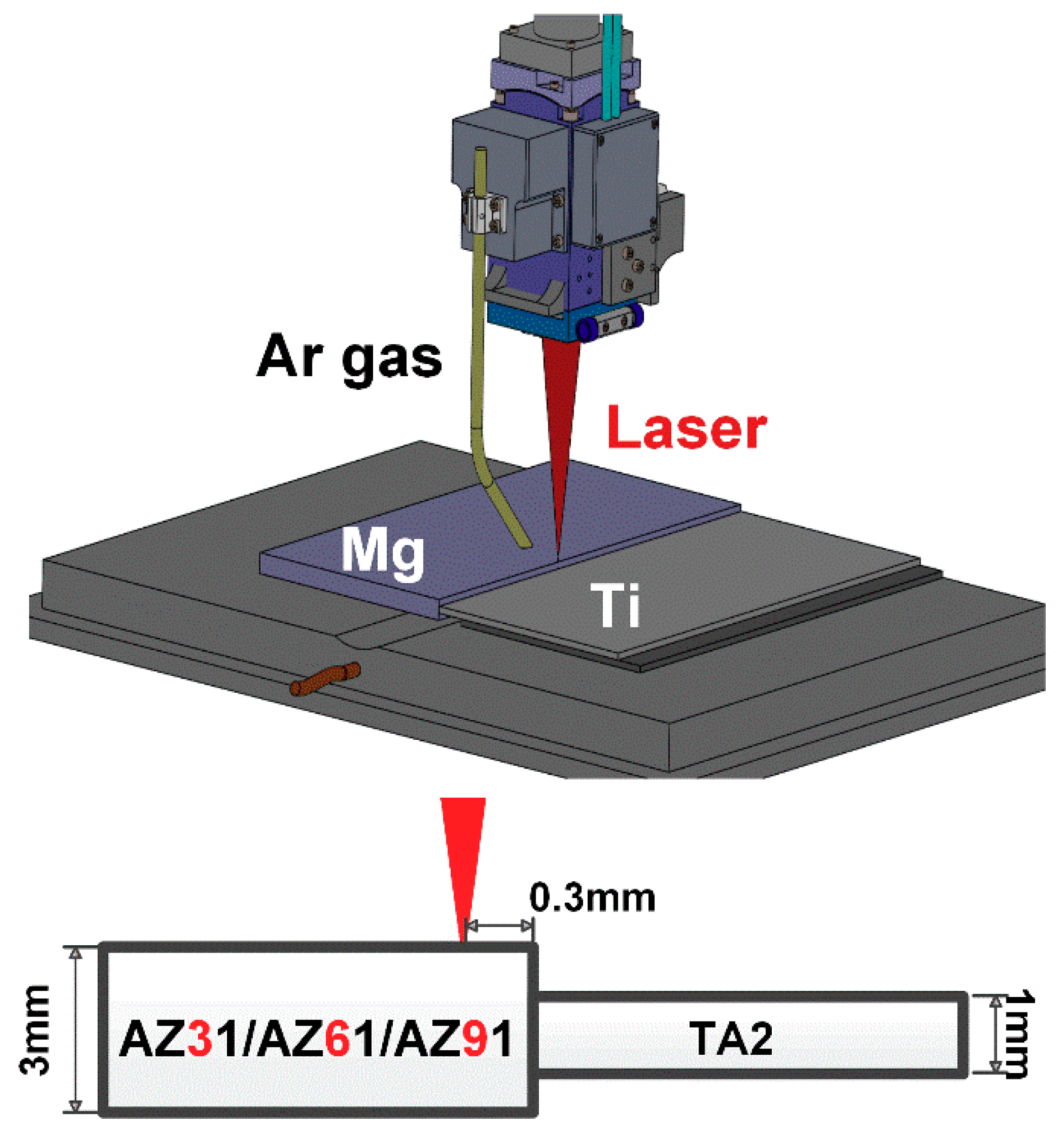
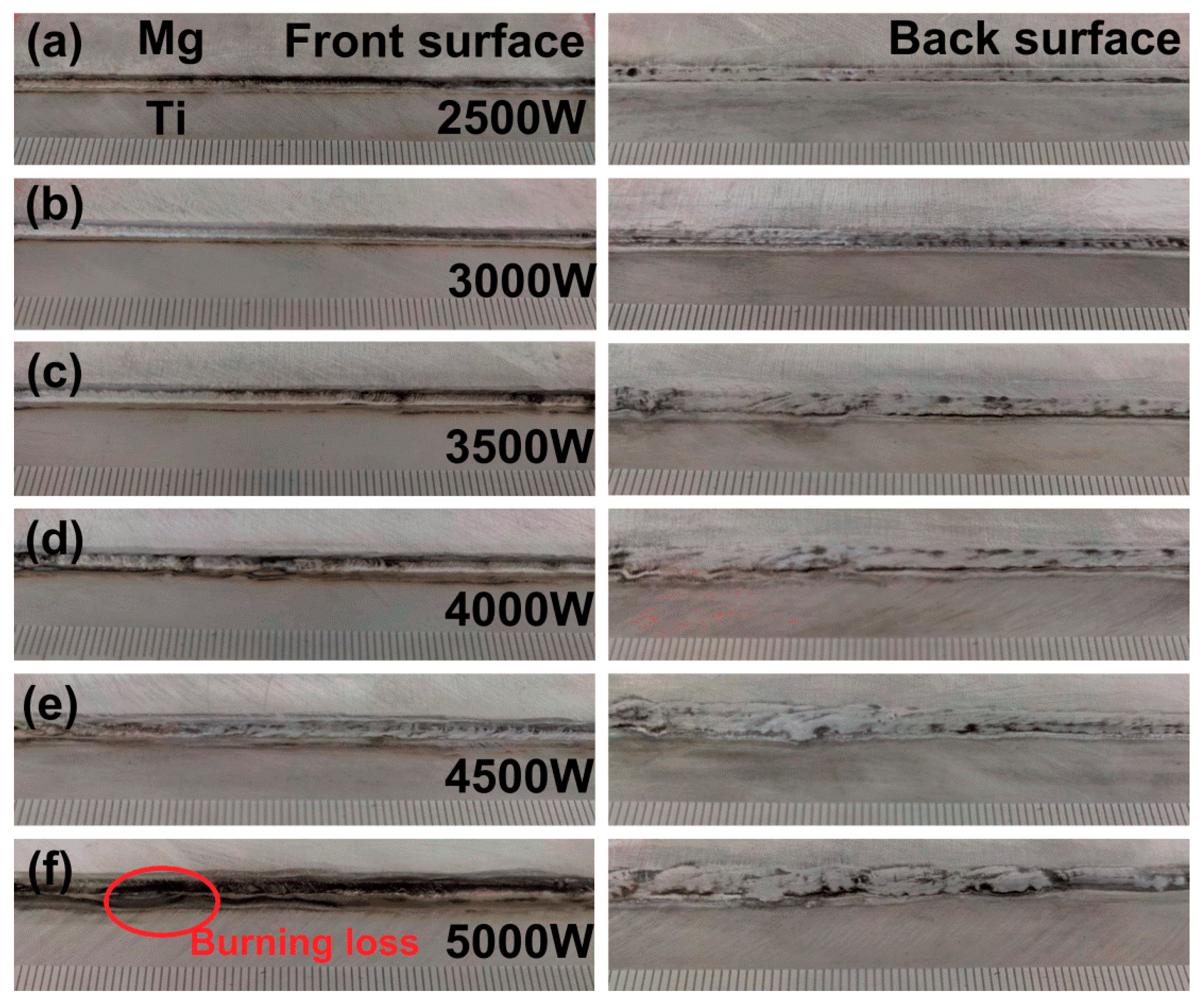
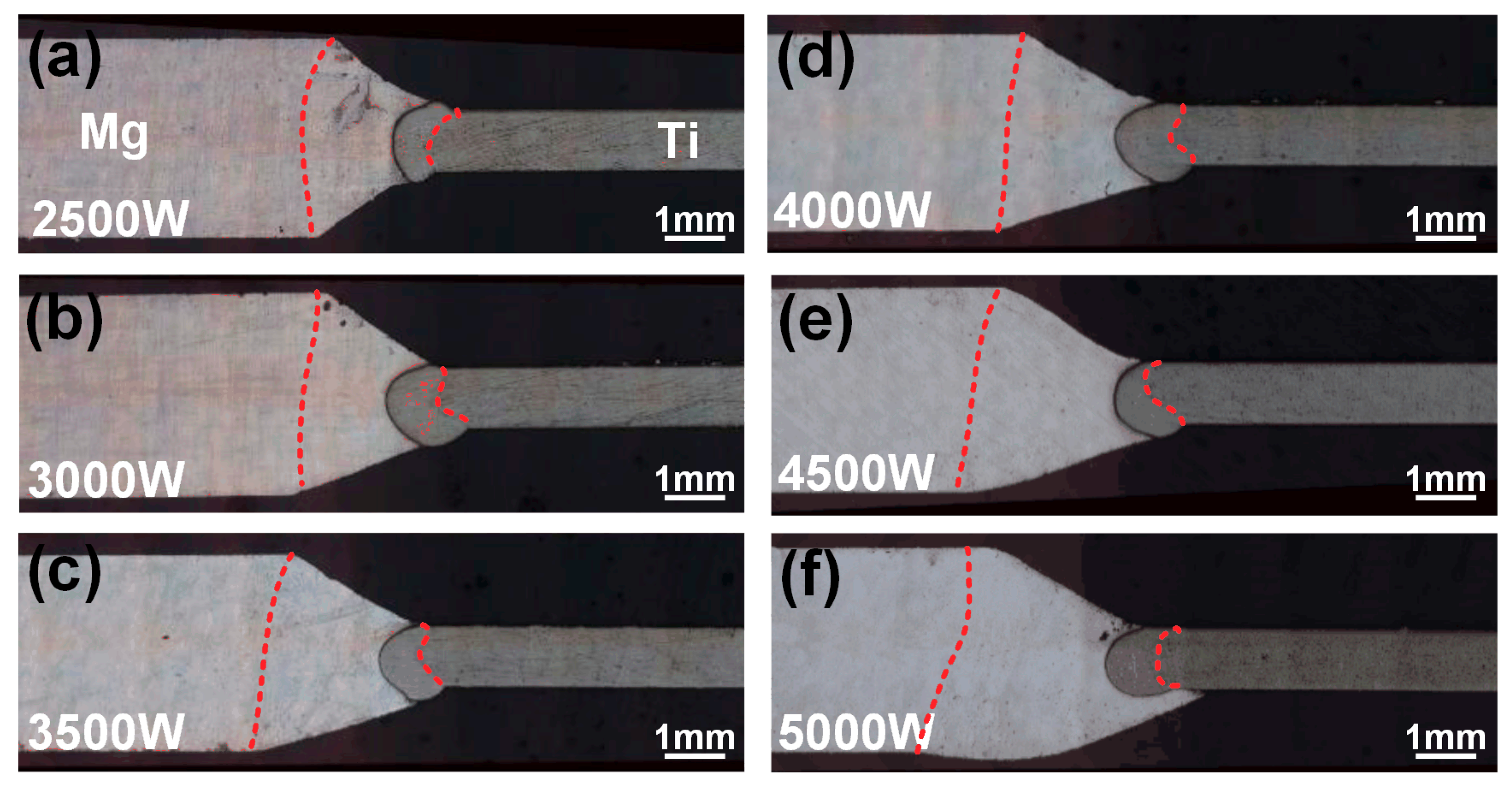
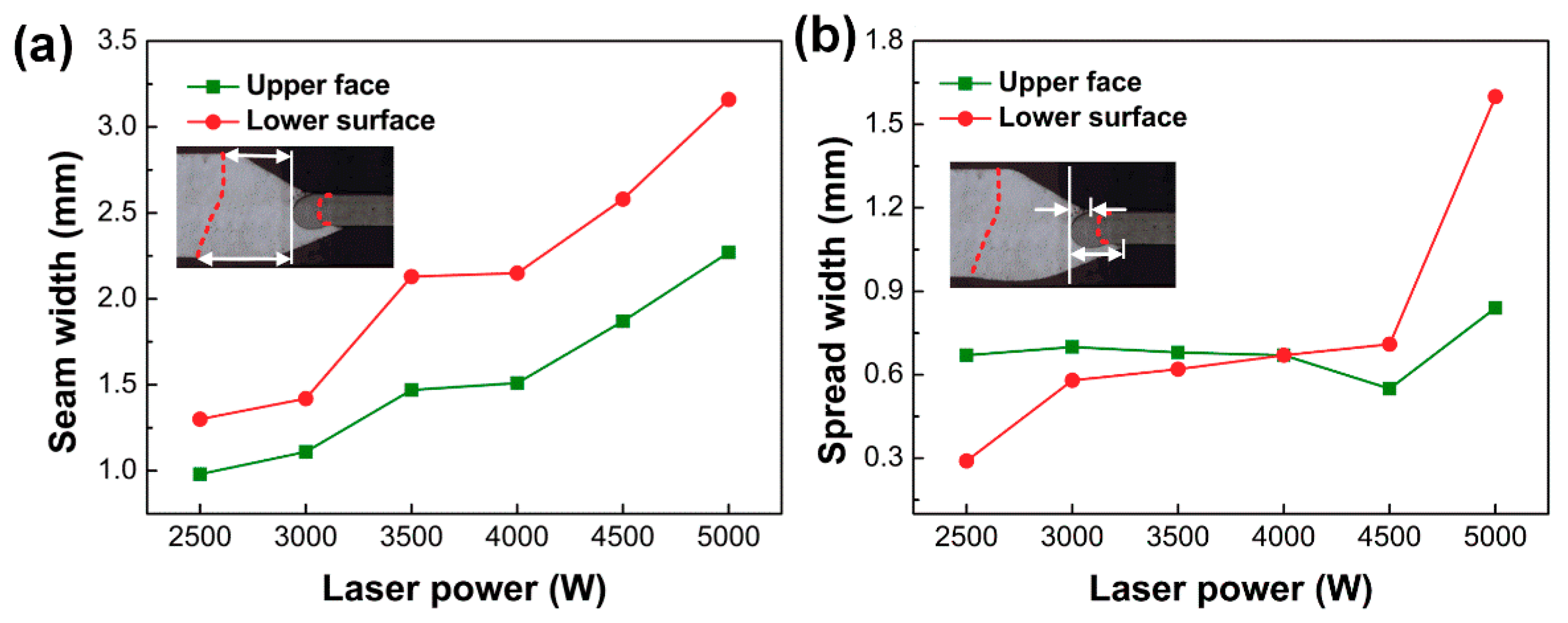
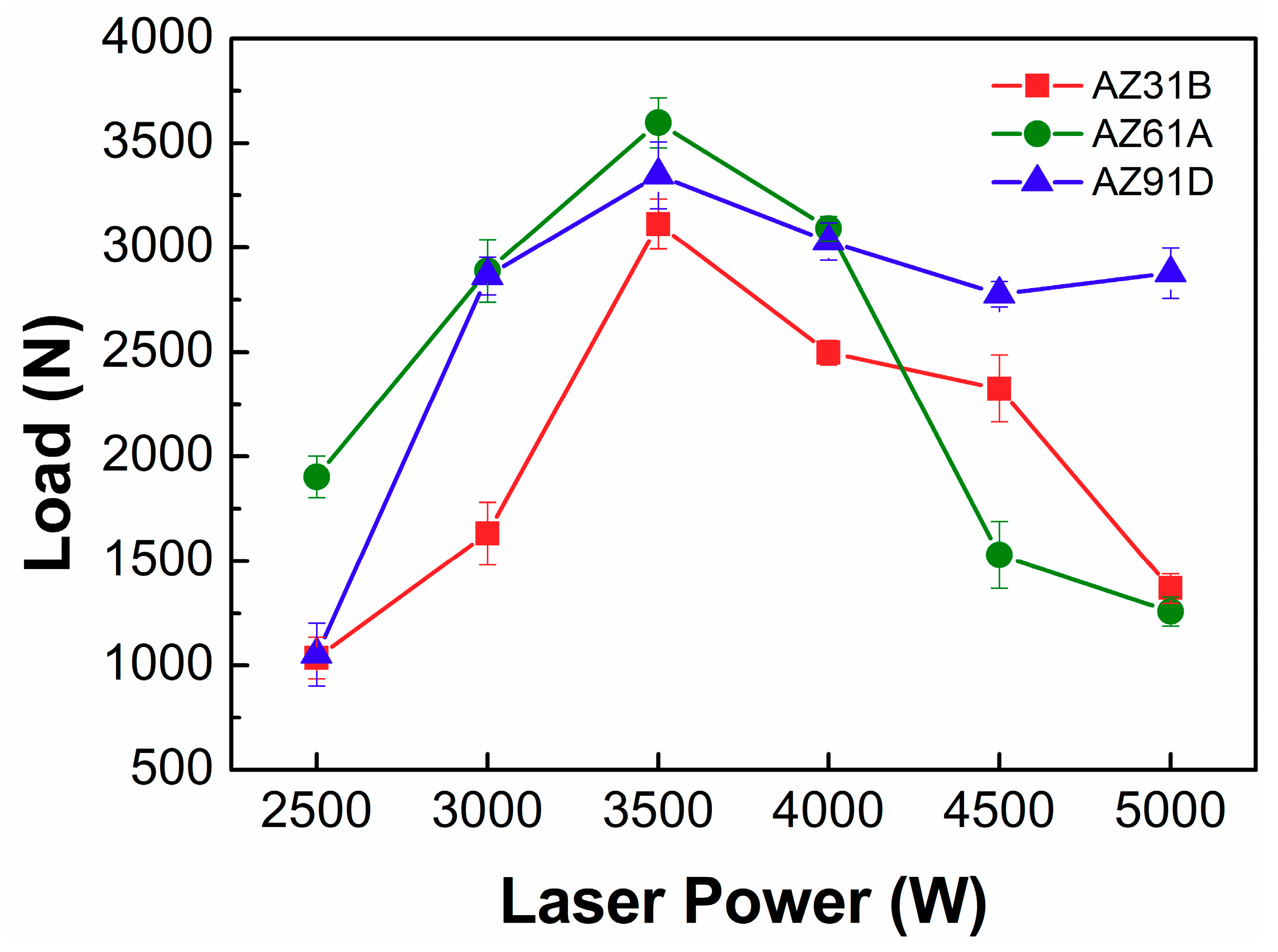





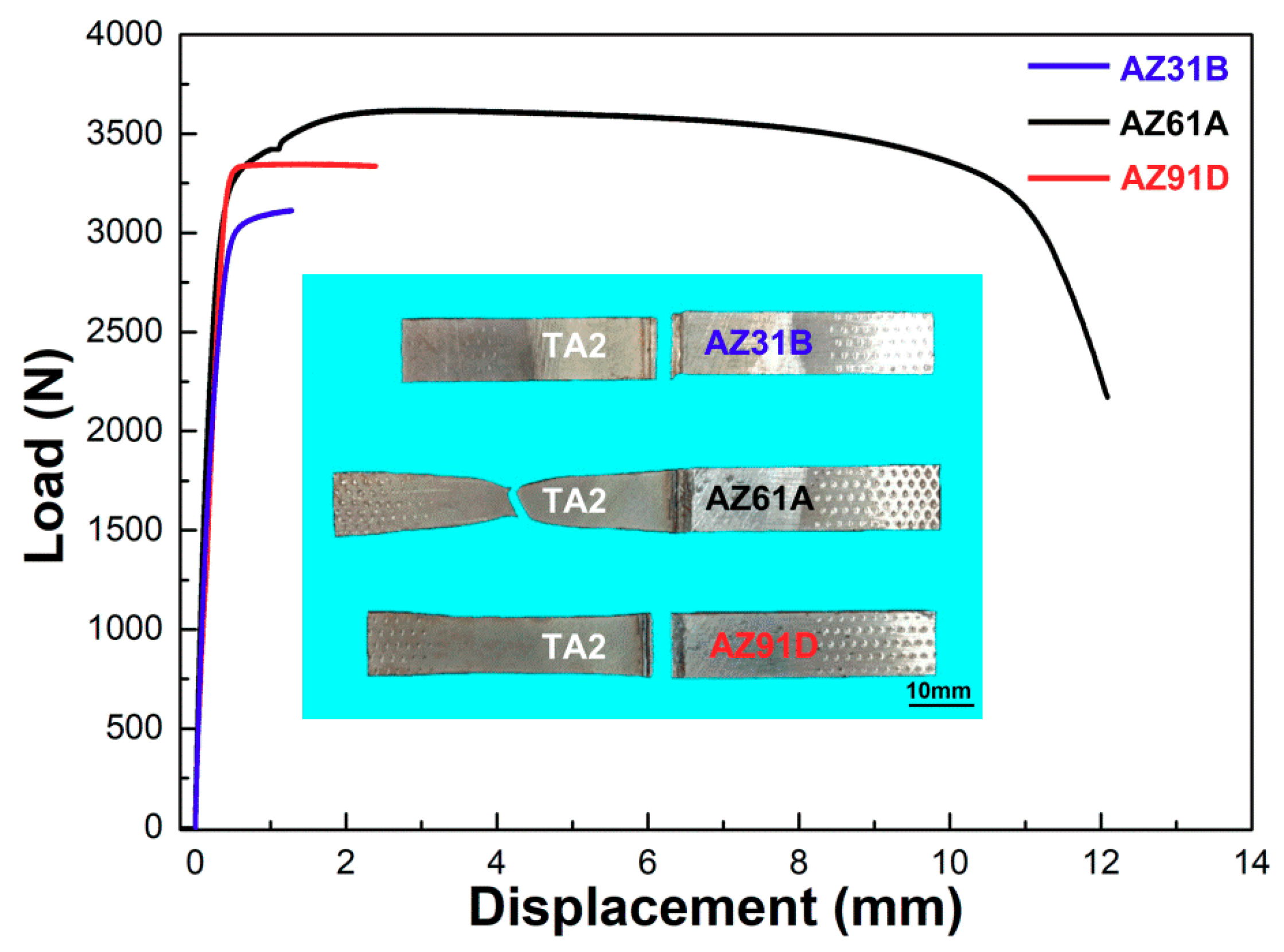
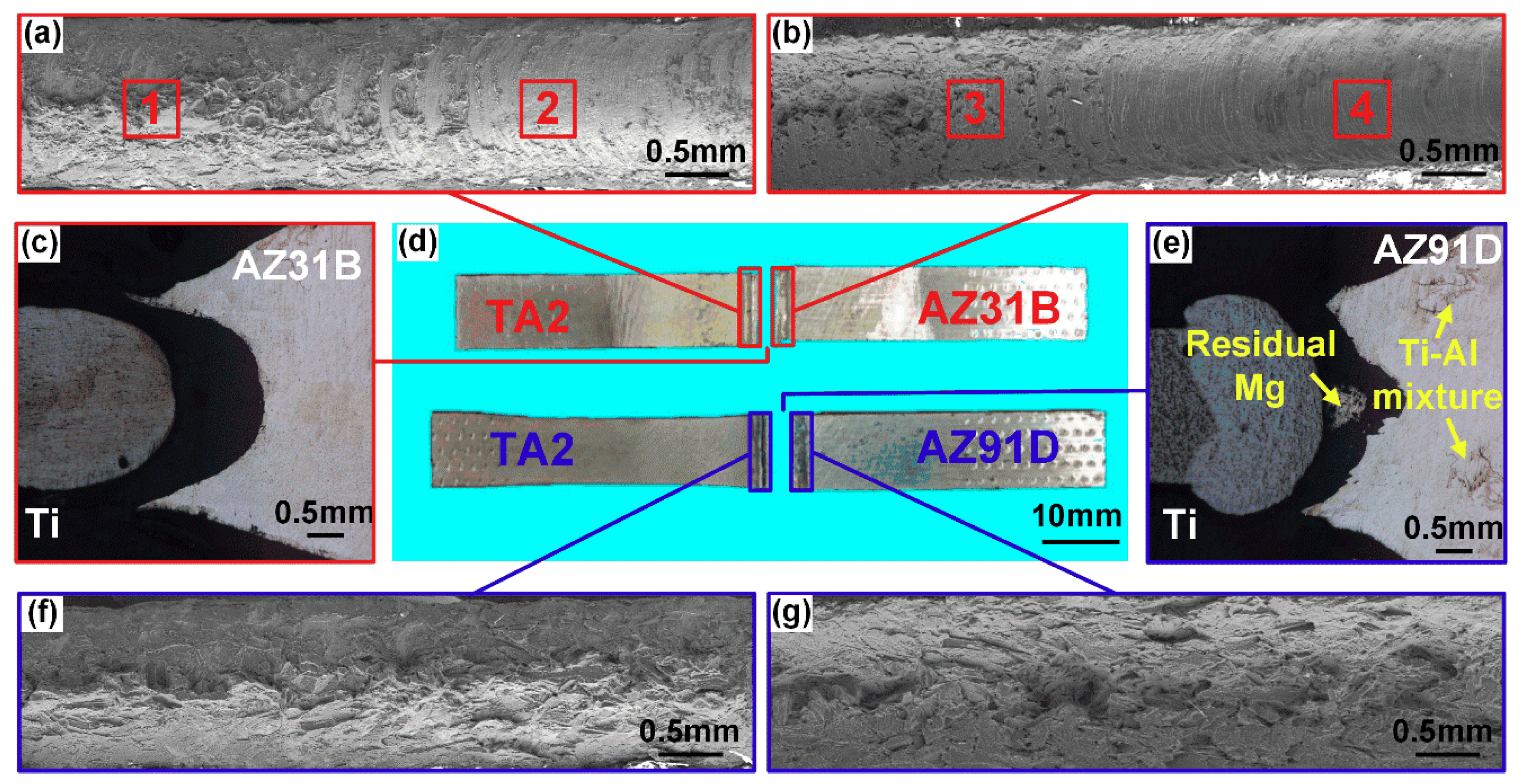


| Materials | Al | Zn | Mn | Fe | Si | Mg | Ti |
|---|---|---|---|---|---|---|---|
| AZ31B AZ61A AZ91D TA2 | 3.00 6.40 9.17 -- | 0.88 0.70 0.65 -- | 0.58 0.24 0.28 -- | 0.018 0.003 0.002 0.070 | 0.015 0.030 0.020 -- | Bal. Bal. Bal. -- | -- -- -- Bal. |
| Experimental Parameters | Value |
|---|---|
| Mg base metal Laser power, W Defocused distance, mm Welding speed, m/min Shielding gas flow rate, L/min Laser offset to Mg side, mm | AZ31B/AZ61A/AZ91D 2500,3000,3500,4000,4500,5000 −1.5 1.5 15 0.3 |
| Elements | Tm/K | nws/d.u. | φ/V | u | V/cm3 | R/P |
|---|---|---|---|---|---|---|
| Mg | 922 | 1.6 | 3.45 | 0.1 | 14 | 0.4 |
| Al | 933.6 | 2.7 | 4.2 | 0.07 | 10 | 1.9 |
| Ti | 1933 | 3.51 | 3.8 | 0.04 | 10.58 | 1 |
| Point | Mg | Al | Ti | Possible Phases |
|---|---|---|---|---|
| 1 2 3 | 89.21 68.27 12.76 | 6.11 31.44 27.08 | 4.68 0.29 60.16 | Mg Mg17Al12 Ti3Al |
| Temperature/K | Without Limit of Al Content | With Lmit of Al Content | ||
|---|---|---|---|---|
| Minimum Gibbs Free Energy (Gm, KJ/mol) | Ti/Al Atom Ratio at Minimum Gm | Minimum Gibbs Free Energy (Gm, KJ/mol) | Ti/Al Atom Ratio at Minimum Gm | |
| 300 | −47.43 | 0.994 | −39.57 | 2.69 |
| 900 | −71.78 | 1.035 | −65.11 | 2.69 |
| 1300 | −98.09 | 0.994 | −91.36 | 2.69 |
| 1600 | −121.00 | 0.955 | −114.31 | 2.69 |
| 2000 | −147.14 | 0.917 | −142.14 | 2.69 |
© 2020 by the authors. Licensee MDPI, Basel, Switzerland. This article is an open access article distributed under the terms and conditions of the Creative Commons Attribution (CC BY) license (http://creativecommons.org/licenses/by/4.0/).
Share and Cite
Dong, W.; Huang, R.; Zhao, H.; Gong, X.; Chen, B.; Tan, C. Effect of Al Content in Magnesium Alloy on Microstructure and Mechanical Properties of Laser-Welded Mg/Ti Dissimilar Joints. Materials 2020, 13, 2743. https://doi.org/10.3390/ma13122743
Dong W, Huang R, Zhao H, Gong X, Chen B, Tan C. Effect of Al Content in Magnesium Alloy on Microstructure and Mechanical Properties of Laser-Welded Mg/Ti Dissimilar Joints. Materials. 2020; 13(12):2743. https://doi.org/10.3390/ma13122743
Chicago/Turabian StyleDong, Wen, Rongrong Huang, Hongyun Zhao, Xiangtao Gong, Bo Chen, and Caiwang Tan. 2020. "Effect of Al Content in Magnesium Alloy on Microstructure and Mechanical Properties of Laser-Welded Mg/Ti Dissimilar Joints" Materials 13, no. 12: 2743. https://doi.org/10.3390/ma13122743




